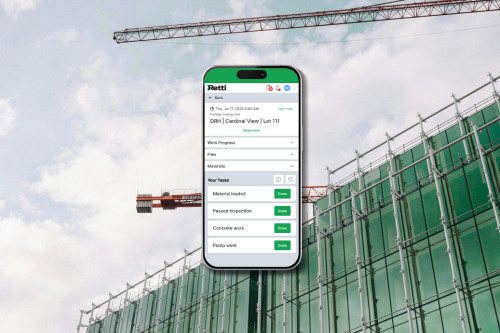Eliminating Chaos: How a Custom Construction Software Transformed Logistics into a Scalable B2B SaaS
Railwaymen partnered with Rusin Concrete Construction to digitize their material supply and job site management. The solution, Retti, moved from a manual, communication-dependent system to an automated, real-time command center, achieving 100% elimination of lost concrete, a 70% reduction in coordination calls, and successfully evolving into a commercial, multi-industry SaaS product. SaaS companies deliver scalable, multi-tenant solutions via the cloud, enabling businesses like Retti to serve multiple industries efficiently. This transformation unlocked key SaaS advantages, including increased innovation, agility, and the benefits of a cloud-native platform. Most SaaS providers now leverage cloud infrastructure to deliver continuous updates, security, and high availability for their customers. Modern SaaS applications and next generation platforms drive innovation, enhance customer experience, and enable better decision-making through advanced features.
Client: Retti (Rusin Concrete Construction) | Industry: Construction Logistics & SaaS
Technology: Ruby on Rails, React, TypeScript, PWA, AWS, Twilio
Key Result: Transformation from an internal operational tool into a versatile, scalable B2B SaaS platform. Unlike traditional software, the new SaaS platform enables rapid deployment, automatic updates, and seamless scalability. Historically, companies had to install and manage their own version of software locally, but SaaS centralizes this process in a single, shared version, reducing complexity and maintenance. SaaS software offers rapid deployment, subscription pricing, and scalability compared to traditional models. As the business grows, the platform makes it easy to add more users, supporting expanded team collaboration and improved productivity.

The Challenge: From Whiteboards and Group Texts to Operational Oversight
We’ve all seen it—construction teams juggling whiteboards in cramped site offices and drowning in endless group text chains just to keep everyone on the same page. These manual coordination approaches might feel familiar, but let’s be honest about what they really deliver: inefficiencies that eat into profits, miscommunication that derails timelines, and that nagging unpredictability that keeps project managers awake at night. Relying on manual methods also makes it difficult to accurately track project timelines, often resulting in delays and budget overruns. As construction ventures grow more ambitious and complex, these time-worn methods start showing their true limitations in ways that simply can’t be ignored.
Here’s where things get interesting—modern construction management software isn’t just changing the game, it’s rewriting the rules entirely. When construction companies embrace SaaS solutions built on robust cloud infrastructure, they’re not just adopting new tools; they’re unlocking a completely different way of thinking about project oversight. These platforms bring teams together seamlessly, whether they’re working from the main office or coordinating from multiple job sites across different time zones. The beauty lies in how naturally these solutions scale alongside growing business ambitions, delivering tangible improvements in operational efficiency, cost control, and project success rates—exactly what forward-thinking companies need to maintain their competitive edge in today’s demanding construction landscape.
Manual Coordination vs. Predictability
When construction teams juggle projects using spreadsheets, emails, and phone calls, the real cost isn’t just inefficiency—it’s the business risk that comes with operating in the dark. We’ve seen countless construction companies struggle with this reality: timelines become moving targets, budgets slip through the cracks, and accountability gets lost somewhere between the office and the job site. This is where modern construction management platforms step in, not as another software solution, but as a strategic partnership between technology and your team’s expertise. These SaaS-based systems create a unified workspace where project managers can finally see the complete picture in real-time, enabling instant collaboration regardless of whether your team is in the field, the office, or anywhere in between. Features like daily logs allow teams to document and reference daily activities and communications, improving accountability and transparency.
The beauty of today’s cloud-based construction management lies in its intelligent accessibility—your team can make critical project decisions from any device, backed by the same accurate, up-to-date information that drives successful outcomes. We understand that for construction leaders, every decision carries weight, and that’s exactly why the shift from manual coordination to digital project intelligence isn’t just about adopting new tools—it’s about transforming how your business operates at its core. This evolution from reactive problem-solving to predictive project management doesn’t just reduce operational costs through fewer errors and delays; it positions your company as a forward-thinking partner that clients can trust with their most important investments. For construction businesses ready to lead rather than follow, embracing these solutions means stepping into a future where every project becomes a showcase of professional excellence.
Cloud Computing and Software as a Service: The Backbone of Modern Construction Management
The construction industry stands at a pivotal moment in its evolution, and if you're leading a construction business today, you've likely witnessed firsthand how digital transformation is reshaping the way projects get delivered. At the center of this shift lies cloud computing and Software as a Service solutions—technologies that are helping forward-thinking companies like yours break free from the operational constraints that have long defined the industry. When we talk with construction leaders, whether they're running general contracting operations or specialized trade businesses, one thing becomes clear: the ability to access enterprise resource planning tools and project management capabilities from anywhere isn't just convenient—it's becoming essential for staying competitive.
What makes this transition particularly compelling is how cloud-based platforms fundamentally change the game for project execution. Your teams no longer need to be tethered to a single office or specific device to make critical decisions that keep projects moving forward. Real-time data access means your field supervisors, project managers, and office staff can collaborate seamlessly, while automatic updates ensure everyone operates with the same, current information. Industry leaders like Oracle have recognized this need, developing robust construction management solutions that bring together scheduling, resource allocation, document management, and compliance tracking in ways that actually make sense for how construction businesses operate day-to-day.
For construction companies ready to embrace this evolution, the business case speaks for itself: enhanced operational efficiency, reduced overhead costs, and the kind of cross-project collaboration that turns good companies into industry leaders. By thoughtfully implementing cloud computing and software as a service solutions, you're not just keeping pace with industry changes—you're positioning your business to deliver projects more reliably while building the scalability needed for sustainable growth. As the construction landscape continues to evolve, these SaaS solutions are proving themselves as the foundation for modern project delivery, driving the innovation and agility that separate industry leaders from those still struggling with yesterday's limitations.
On-Premise vs Cloud-Based Solutions: Why the Shift Matters
Understanding the construction industry means recognizing a fundamental truth: the shift from on-premise software to cloud-based SaaS solutions isn't just a trend—it's a strategic necessity driven by real business challenges we've witnessed firsthand. Traditional software creates genuine pain points that impact your bottom line: local installations that tie up resources, maintenance overhead that diverts focus from core projects, and manual update cycles that leave teams working with outdated tools. When you're managing multiple project sites and diverse teams, these technological constraints become operational bottlenecks that directly impact project delivery timelines and profitability.
What makes cloud-based SaaS solutions genuinely transformative isn't just their technical capabilities—it's how they align with the way construction businesses actually operate. Your teams need access from jobsites, offices, and client meetings, across devices and time zones. SaaS delivers this flexibility naturally, with a unified platform that serves your entire organization without the complexity of managing separate installations or worrying about version inconsistencies. The enhanced security, automatic updates, and seamless integration capabilities we build into these solutions ensure your business stays competitive while reducing the IT burden on your internal resources. This isn't theoretical—it's practical technology that adapts to your workflow, not the other way around.
The broader transformation we're seeing across construction companies reflects something deeper: a recognition that the right technology partner can fundamentally change how you deliver value to your clients. Real-time data access, streamlined maintenance, and scalable user management aren't just features—they're enablers of business growth and innovation. Companies that embrace this evolution aren't just adopting new software; they're positioning themselves to respond more effectively to market demands, deliver exceptional client experiences, and build sustainable competitive advantages in an increasingly dynamic industry landscape.
.png) source: retti.com
source: retti.com
The Challenge: From Whiteboards and Group Texts to Operational Oversight
Retti originated as a critical internal project for Rusin Concrete Construction, a specialized construction and logistics company based in Colorado, USA. They manage significant volumes, handling 150,000 cubic yards of concrete company-wide and completing between 500 and 900 projects annually. The scale of operations required a solution capable of supporting multiple users across different roles and departments. Additionally, they needed a platform that could manage the entire project lifecycle, from planning to completion.
Manual Coordination vs. Predictability
The core operational challenge was a fundamental lack of systemic control over supply chain logistics. Prior to the project, all scheduling and coordination relied entirely on manual methods:
-
Scheduling: Managed inefficiently on physical office whiteboards.
-
Communication: Solely dependent on text messages and phone calls, leading to communication silos, slow response times to on-site changes, and a complete lack of real-time oversight.
-
Impact: Overlapping orders, resource misallocation, and substantial material loss (e.g., lost concrete).
Previous solutions depended on local installation and on premises software, which limited scalability and flexibility. These solutions required software to be installed and managed on local computers, increasing complexity and maintenance.
The client approached the project with caution due to a previous, failed attempt at digital transformation with another vendor. The primary goal was clear: to build a dependable, scalable solution that could fully digitize and automate the material supply and management process, ultimately creating a foundation for a commercial SaaS offering. Unlike traditional software, the SaaS approach provides cloud-based delivery, automatic updates, and eliminates the need for complex hardware maintenance. Cloud computing, in its basic form, provides essential resources like software and data storage over the web. Infrastructure as a service (IaaS) represents the most basic form of cloud services, serving as the foundational layer for SaaS platforms.
Strategic Discovery: De-Risking the Project and Defining Scalability
The success of the Retti platform was rooted not in immediate coding, but in a structured, two-stage Product Discovery process that mitigated the risk of repeating past failures. This strategic approach became the foundation of the partnership. The Product Discovery process also helped define the SaaS business model, including considerations for subscription-based revenue and scalability to support a multi-tenant cloud environment. The discovery process included planning for agile application development practices, ensuring the team could support continuous improvement and frequent releases.
This foundation for commercialization was further strengthened by designing the architecture to enable rapid deployment of new features and updates, allowing the platform to quickly respond to customer needs and market changes.
Two-Stage Workshop Approach
-
Stage One (Krakow Office, Poland): The initial workshop focused on deep problem identification, stakeholder alignment, and defining the core business objectives. It established the baseline requirements for a functional internal tool.
-
Stage Two (Client HQ, USA): This intensive follow-up session transformed the project’s scope. It evolved the initial concept of a rigid internal management tool into a vision for a flexible, commercially viable, and multi-tenant B2B SaaS product. The platform operates on a single instance model, efficiently serving multiple clients from the same software environment. The commercial SaaS offering is delivered on a subscription basis, providing predictable costs for clients. The platform is hosted by a leading cloud provider, ensuring scalability and reliability.
This two-step consultation ensured the architecture and feature set were designed for future commercialization from day one, rather than being an afterthought.
The Retti Construction Management Software Solution: Real-Time Command & Communication Workflow
The Retti platform was engineered to replace guesswork and manual communication with a precise, automated, and measurable operational system. It delivers essential services for construction logistics and project management, ensuring seamless collaboration and efficiency. The platform manages communication, scheduling, and resource allocation automatically, reducing manual effort and minimizing errors. As a SaaS platform, Retti functions as a centralized service for all users involved in the project, streamlining operations and enhancing project outcomes. As SaaS software, Retti is delivered via the cloud, offering scalability and rapid deployment without the need for local installation.
Live Command Center
The system’s core is a dynamic operational dashboard, designed to serve as a Live Command Center for dispatchers and managers. It provides:
-
Real-Time Integration: Task assignments, employee locations, and vehicle positions are integrated in real time via GPS.
-
The platform supports custom workflows tailored to each company's processes, allowing teams to adapt the dashboard to their unique operational needs.
-
Users can also create custom applications within the platform to address specific project tracking or compliance requirements.
-
Proactive Planning: The “Hot Seat” / “On Deck” view provides a 3-day operational forecast, enabling dispatchers to react instantly to unexpected changes, dynamically assign tasks, and optimize delivery routes based on current field data.
-
Predictability: Every task is assigned a specific time, location, contractor, and status, ensuring continuous project clarity.
SMS-Based Workflow for Field Teams
To ensure 100% adoption across all users—including subcontractors and field workers without access to the app—a simple, effective communication layer was implemented using Twilio:
-
Seamless Adoption: Users receive task details via a standard text message.
-
Instant Updates: Task completion is confirmed by simply replying to the message, which instantly updates the status in the main system.
-
Efficiency: This workflow eliminates the need for app installation or complex training, making the onboarding process instantaneous.
Modular Integration Layer
To address the necessity of interacting with external, specialized systems (e.g., Concrete Direct), the platform was built with a configurable, modular architecture. This design isolates third-party integrations, allowing new systems to be added safely and easily without introducing technical debt, a critical factor for B2B SaaS scalability.
The platform can integrate with ERP and enterprise resource planning systems to streamline back-office operations, as well as with human resources platforms to enable better workforce management.
Document Management: Bringing Order to Construction Chaos
Every construction professional knows the frustration: critical blueprints buried somewhere in email chains, contract versions scattered across different computers, and that sinking feeling when you realize the team's been working from outdated specifications. Traditional document management—those familiar folders stuffed with papers and files saved locally on individual machines—creates more headaches than it solves. What starts as a simple organizational challenge quickly escalates into costly project delays, compliance nightmares, and the kind of miscommunication that keeps project managers awake at night.
Here's where modern cloud-based document management transforms the entire game. Today's SaaS platforms don't just store your documents—they create intelligent workflows that actually understand how construction teams operate. Real-time collaboration becomes second nature when your entire project ecosystem lives in one secure, accessible space. Automatic updates ensure everyone works from the same page, literally. Enhanced security protocols protect sensitive project data, while scalable storage grows alongside your business ambitions. The result? Your team focuses on what they do best—delivering exceptional construction projects—rather than wrestling with document chaos.
Smart construction companies are discovering that SaaS-based document management isn't just about organization—it's about competitive advantage. Improved collaboration translates directly to faster project delivery. Reduced administrative overhead means resources flow toward revenue-generating activities. Enhanced compliance capabilities provide peace of mind in an increasingly regulated industry. When document management becomes effortless, everything else falls into place: clearer communication, streamlined processes, and projects that consistently exceed client expectations.
Technology & Architecture: A Foundation for Commercial Growth
The architecture choice was driven by the long-term goal of commercializing the product. Railwaymen built the system from scratch, prioritizing scalability, stability, and speed of development. The SaaS model ensures that software maintenance, including updates and security, is managed by the provider, reducing the burden on users. This architecture also supports advanced features such as machine learning and secure data storage, enabling innovative functionalities and reliable performance. SaaS customers benefit from these architectural choices, enjoying seamless access and improved service, much like how email services are delivered via SaaS platforms.
API-First Architecture & Technology Stack
The choice of an API-first, modular architecture ensures the platform can be easily customized for different sectors (e.g., design, logistics) without substantial re-engineering.
| Component | Technology | Rationale |
| Backend (API) | Ruby on Rails | Stability, rapid development, and extensive ecosystem for complex business logic (ideal for scalable SaaS). |
| Frontend | React, TypeScript | High-performance user interfaces and reduced errors. |
| Mobile Access | PWA (Progressive Web App) | Provides a near-native app experience without the constraints of app stores. |
| Hosting/DevOps | AWS | Cloud scalability and reliability. |
| Key Integrations | Twilio, Concrete Direct | Communication workflow and specialized data exchange. |
Measurable Business Impact and Evolution to a SaaS Product
The internal solution quickly delivered quantifiable results, validating the strategic approach and proving its commercial viability. Other benefits of the SaaS model include scalability, cost savings, and seamless integration with existing systems.
With commercial deployment, SaaS customers and customers across industries now benefit from the platform's advanced features. The platform enables users to create detailed, professional estimates that help win and complete more jobs efficiently, leading to improved customer satisfaction.
Tangible Operational Improvements
The platform achieved significant, measurable operational gains:
-
Material Integrity: 100% elimination of lost concrete volume.
-
Communication Efficiency: Coordination-related phone calls dropped by approximately 70%.
-
Time Savings: Average time for task assignment was reduced by over 50%.
-
Logistics Optimization: Real-time tracking minimized empty runs and improved overall resource allocation for the 60,000 cubic yards poured by the residential division annually.
Business Transformation: From an Internal App to Retti SaaS
The project's most significant success is its evolution into a standalone commercial product. The system, originally designed strictly for internal logistics and scheduling, leveraged its flexible and modular architecture (defined during the Discovery workshop) to become the Retti SaaS Platform.
Retti is now successfully deployed with other clients across various industries, confirming the robust design and business value of the solution. Project management for its users is now fully measurable and predictable, providing continuous clarity on responsibilities, locations, and status.
"What originated as a solution for Rusin Concrete Construction has now been further developed into a full suite SaaS platform called Retti... Partnering with Railwaymen for our offshore software development has been one of the best strategic decisions we’ve made. They’ve played a critical role in building and evolving our platform, delivering consistent quality and reliability." - Katie Walker, Retti
De-Risk Your Digital Transformation. Schedule a Strategic Consultation.
Retti's successful journey from operational chaos to a profitable, scalable B2B SaaS platform began with a structured strategic partnership. Let's explore how the Railwaymen Product Discovery process can de-risk your project and provide a solid, technical foundation for your next scalable software system.

.png)
.png)


